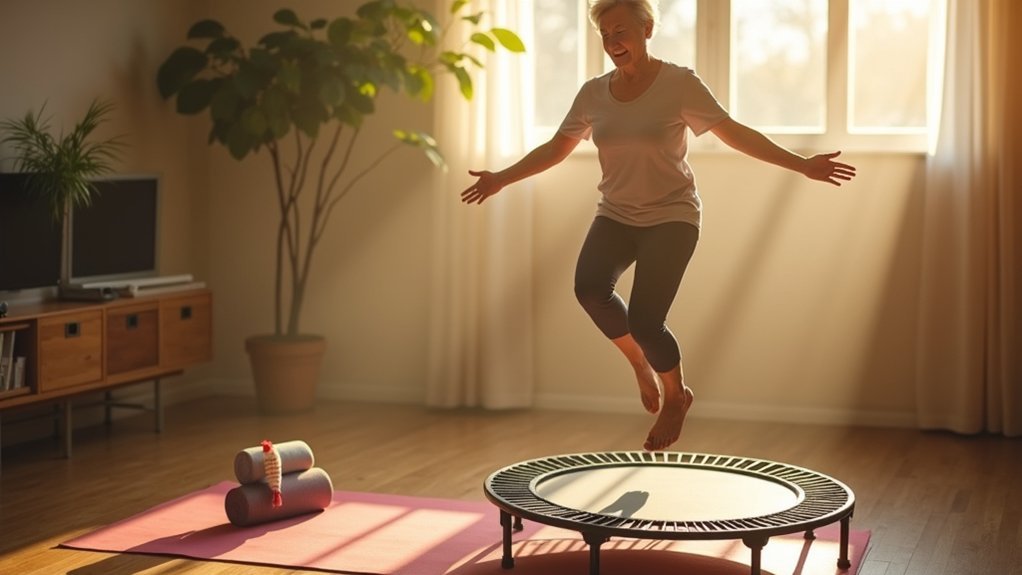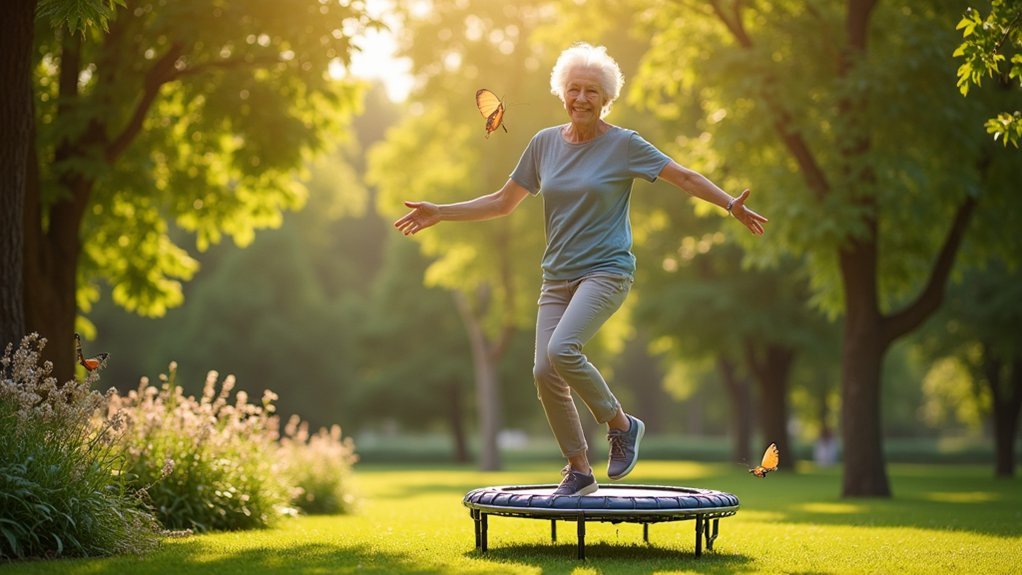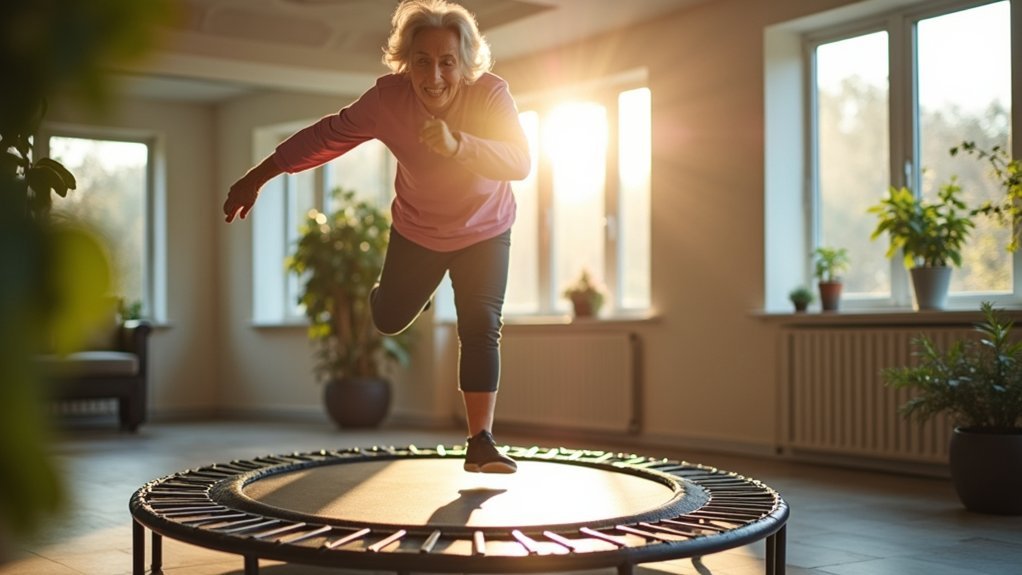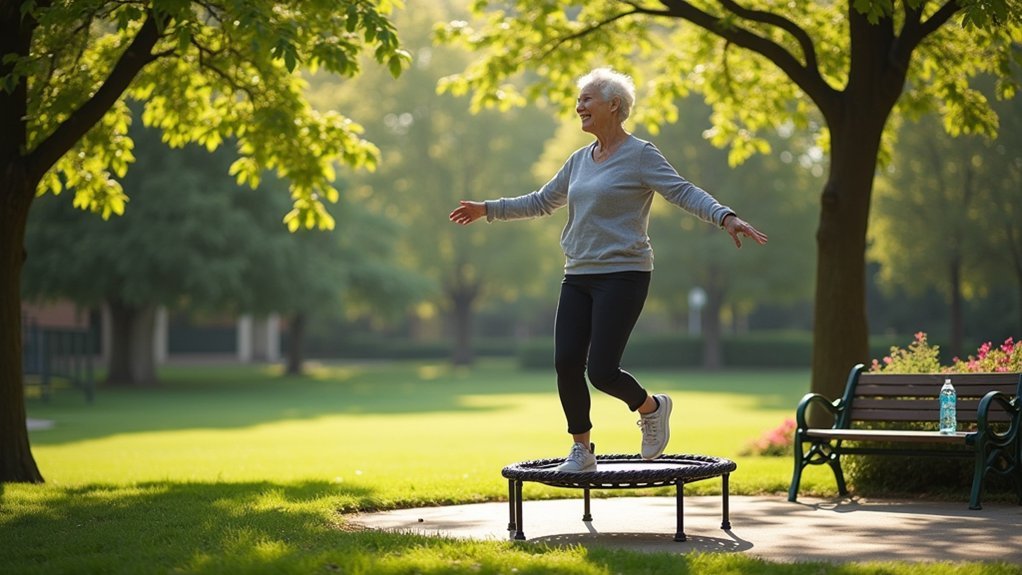Rebounding is safe for older adults because it absorbs 80% of the impact on joints while still providing cardiovascular benefits. You’ll find stability features like non-slip mats and optional handlebars to prevent falls. The exercise allows for progressive adaptation through seated options and chair-assisted routines for those with limited mobility. NASA-validated research confirms its effectiveness while minimizing strain. Discover how this gentle, joint-friendly exercise can transform your fitness journey without risking injury.
The Joint-Friendly Nature of Rebounding Exercise

While many exercise options can stress aging joints, rebounding offers a remarkably gentle alternative for older adults. When you bounce on a rebounder, the springy surface absorbs about 80% of the impact that would normally travel through your knees, hips, and spine on hard surfaces.
This gentle, rhythmic motion enhances your synovial fluid circulation, naturally lubricating your joints and reducing stiffness—especially beneficial if you have arthritis. The Boogie Bounce rebounder includes a patented T-bar handle that provides extra stability and support during workouts. The repetitive bouncing delivers nutrients to your cartilage while decreasing friction between joint surfaces.
What makes rebounding particularly effective is how it strengthens the muscles surrounding your joints without overloading them. You’ll engage leg, core, and back muscles simultaneously, improving stability and reducing overall joint stress while maintaining mobility.
Stability Features That Prevent Falls During Rebounding
Beyond joint protection, fall prevention becomes a top priority for older adults considering rebounding exercise. Modern rebounders incorporate several safety features that greatly reduce fall risks.
The non-slip mat texture provides secure footing even during sweaty workouts, while customizable spring tension prevents overextension that could cause balance loss.
You’ll benefit from available handlebars that offer support during challenging movements, and the wide base with rubberized feet guarantees the equipment remains stable. Low clearance height minimizes distance to the floor if balance is compromised.
Your training can begin with seated options and chair-assisted shifts before progressing to standing exercises. When standing, practice low-impact bouncing (under 6 inches) and anchored stability drills with one hand on a wall for added security as your balance improves by up to 35% with consistent practice. Consulting with a healthcare provider is essential before starting rebounding, especially for individuals with previous medical concerns or conditions.
Cardiovascular Benefits Without Excessive Strain

Unlike high-impact exercises that can strain aging bodies, rebounding delivers impressive cardiovascular benefits without overtaxing your system. The gentle bouncing motion steadily elevates your heart rate while minimizing joint stress, strengthening your heart muscle and improving circulation.
Gentle on joints yet powerful for your heart—rebounding offers mature bodies the perfect cardiovascular workout without the wear and tear.
You’ll experience lower blood pressure and improved cholesterol levels as regular rebounding enhances endothelial function and reduces arterial stiffness.
The controlled movements increase your VO₂ max and aerobic efficiency while allowing you to adjust intensity to match your personal endurance level. This provides a low-impact workout that’s particularly suitable for elderly individuals with joint concerns.
After your session, you’ll continue burning calories with improved nocturnal circulation and lower resting heart rates.
The rhythmic nature of rebounding creates beneficial exertion-recovery cycles similar to interval training, but without the exhaustion typically associated with high-intensity workouts.
Progressive Adaptation Options for Various Mobility Levels
You’ll find rebounding more accessible with handrail supports that provide stability while you build confidence on the mini-trampoline.
These supportive aids let you safely participate regardless of your current mobility limitations, transforming what might seem challenging into an achievable exercise option.
Following gradual intensity protocols guarantees you’ll progress at an appropriate pace, starting with simple bouncing movements before advancing to more dynamic exercises as your balance and strength improve. Positioning your rebounder on a level surface helps prevent accidents and ensures you maintain proper form throughout your workout.
Handrail Support Integration
While many rebounders come standard with basic handrail systems, integrating proper support structures requires careful consideration of an older adult’s specific mobility needs.
Look for rebounders with round handrails approximately 38mm in diameter, which enable maximum force generation and balance recovery. Position rails at 36-42 inches high for ideal upper-body stabilization during exercise.
For those with reduced mobility, consider models offering dual-tiered rails at different heights (32″ and 38″) to accommodate various requirements.
Non-slip, rubberized coatings maximize grip security, while high-contrast visual markers help with targeting during momentary balance loss. Research has shown that maintaining balance in aging populations significantly improves overall quality of life and independence.
If possible, choose systems with thermoplastic elastomer materials that balance durability with tactile feedback.
These features collectively guarantee you’ll maintain stability while gradually building confidence on your rebounder regardless of your current fitness level.
Gradual Intensity Protocols
Adapting to rebounding exercise requires a carefully structured approach for older adults, especially when considering varying mobility levels and physical capabilities.
Begin with seated bouncing for 2-minute sessions, incorporating static holds between movements to build confidence. As you progress, introduce rhythmic bouncing at a slow 1-2 second cadence, limiting vertical displacement to 1-2 inches initially.
For those with mobility concerns, utilize chair-assisted routines or practice partial weight-bearing exercises. This approach provides a low-impact exercise option that significantly reduces stress on joints compared to traditional exercises. Start with once-weekly sessions before advancing to twice weekly, and increase duration by just 2-5 minutes as your tolerance improves.
Monitor your progress through bi-weekly assessments of walking speed and comfort levels, advancing only when you’ve achieved 75% adherence with no adverse events.
Remember to check your heart rate regularly and take scheduled hydration breaks.
Evidence-Based Safety Profile for Neurological Conditions

Studies examining rebounding for individuals with neurological disorders suggest it’s a safe, effective exercise option for those with Parkinson’s disease, stroke, and multiple sclerosis.
Research shows participants with mild neurological disabilities can safely engage in rebounding activities, experiencing significant improvements in mobility and functional capacity.
The low-impact nature of rebounding accommodates varying levels of ability, making it particularly suitable if you have mobility challenges.
You’ll benefit from the progressive nature of this exercise—you can start gently and gradually increase intensity as your confidence and ability improve.
Group rebounding sessions may offer additional benefits through community engagement, potentially improving your adherence to exercise routines.
While promising for mild to moderate impairments, consult your healthcare provider before beginning any new exercise program.
Meta-analysis results demonstrated that participants using rebound exercise improved their mobility, with TUG time decreasing by approximately 6.08 seconds compared to 3.18 seconds in control groups.
NASA-Validated Impact Reduction Technology
NASA’s groundbreaking research in the 1980s validated rebounding as an effective, low-impact exercise option for older adults concerned about joint health. Their studies revealed that astronauts lost 15% of bone and muscle mass in just two weeks of spaceflight, emphasizing the importance of gravity-simulating exercise.
What makes rebounding uniquely safe is its even distribution of G-forces throughout your body. Unlike jogging, where impact concentrates in your knees and hips, the trampoline’s elastic surface disperses forces while creating enough mechanical load to stimulate bone-strengthening osteoblast activity. This safety aspect is particularly important as rebounding puts less stress on joints than traditional running activities.
You’ll experience lower peak impact forces due to the non-linear force curve of the rebounding surface. This creates a fluid shift between muscle phases with momentary joint decompression during the upward bounce—providing the benefits of weight-bearing exercise without compromising joint integrity.
Frequently Asked Questions
How Long Should Seniors Rebound in a Single Session?
You should start with 5-10 minutes per rebounding session, gradually increasing by 2-5 minutes weekly as your strength improves. Don’t overdo it – prioritize consistency with 3-5 shorter sessions weekly rather than one long session.
Can Rebounding Help With Specific Medication Side Effects?
Yes, rebounding can help reduce side effects like high blood pressure, edema, dizziness, and fatigue. You’ll find it improves circulation, strengthens your lymphatic system, and enhances balance, potentially offsetting many medication-related issues.
Is Rebounding Effective for Seniors With Cognitive Impairments?
Yes, rebounding can help seniors with cognitive impairments. You’ll benefit from improved blood flow to your brain, which enhances memory and concentration. It also boosts mood and provides engagement that builds confidence.
How Does Rebounding Compare to Water Aerobics for Seniors?
Both offer low-impact exercise that’s gentle on your joints. You’ll find rebounding more accessible at home, while water aerobics provides buoyancy support. They’re equally effective for balance, coordination, and cardiovascular health.
Can Rebounding Exercises Be Modified for Wheelchair Users?
Yes, you can adapt rebounding exercises for wheelchair use by focusing on upper body movements, using assistive devices, engaging your core, and following visual guides with proper supervision for safety and technique.
In Summary
You’ve discovered that rebounding combines joint protection, stability features, and adjustable intensity that’s perfect for your aging body. You’ll experience cardiovascular benefits without harsh impacts, and can modify exercises to match your mobility level. The evidence supports its safety even with neurological conditions, while NASA-backed technology reduces impact by up to 87%. Start slowly, listen to your body, and bounce your way to better health.





Leave a Reply